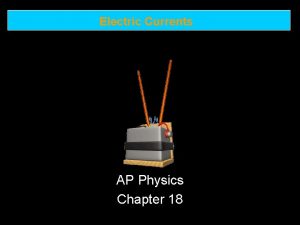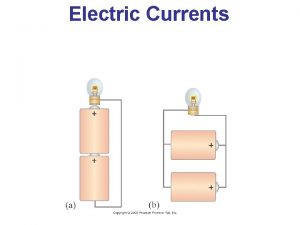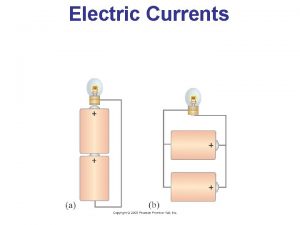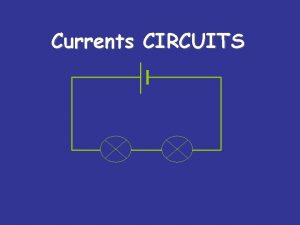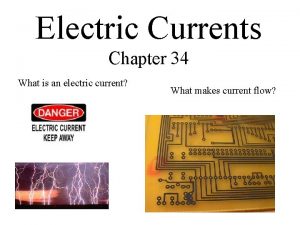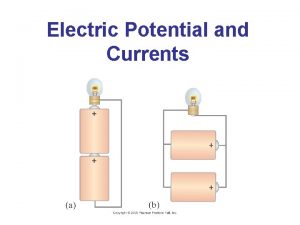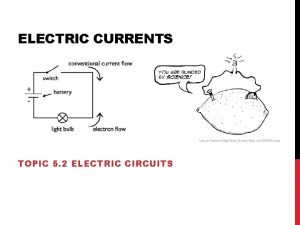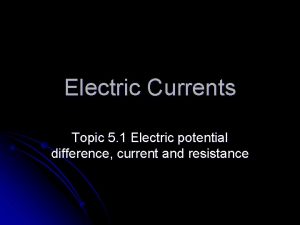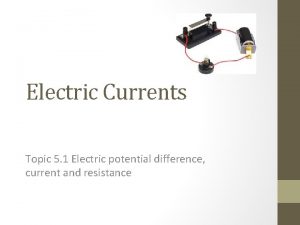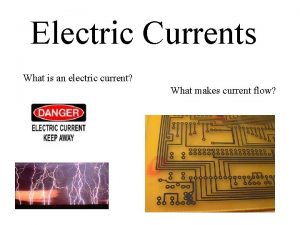Chapter 18 Electric Currents 18 1 The Electric































- Slides: 31

Chapter 18 Electric Currents

18. 1 The Electric Battery Volta discovered that electricity could be created if dissimilar metals were connected by a conductive solution called an electrolyte. This is a simple electric cell.

A battery transforms chemical energy into electrical energy. Chemical reactions within the cell create a potential difference between the terminals by slowly dissolving them. This potential difference can be maintained even if a current is kept flowing, until one or the other terminal is completely dissolved.

Several cells connected together make a battery, although now we refer to a single cell as a battery as well.

18. 2 Electric Current Electric current is the rate of flow of charge through a conductor: Unit of electric current: the ampere, A. 1 A = 1 C/s.

18. 2 Electric Current A complete circuit is one where current can flow all the way around. Note that the schematic drawing doesn’t look much like the physical circuit!

In order for current to flow, there must be a path from one battery terminal, through the circuit, and back to the other battery terminal. Only one of these circuits will work:

By convention, current is defined as flowing from + to -. Electrons actually flow in the opposite direction, but not all currents consist of electrons.

18. 3 Ohm’s Law: Resistance and Resistors The ratio of voltage to current is called the resistance: Joules of energy with Ohms Law: ∆PE = (∆Q)V = (I∆t)V Experimentally, it is found that the current in a wire is proportional to the potential difference between its ends.

In many conductors, the resistance is independent of the voltage; this relationship is called Ohm’s law (a). Materials that do not follow Ohm’s law are called nonohmic (b). Unit of resistance: the ohm, Ω. 1 Ω = 1 V/A.

Standard resistors are manufactured for use in electric circuits; they are color-coded to indicate their value and precision.


Some clarifications: • Batteries maintain a (nearly) constant potential difference; the current varies. • Resistance is a property of a material or device. • Current is not a vector but it does have a direction. • Current and charge do not get used up. Whatever charge goes in one end of a circuit comes out the other end.

18. 4 Resistivity The resistance of a wire is directly proportional to its length and inversely proportional to its cross-sectional area: V= I ρL A The constant ρ is the resistivity, this is a characteristic of the material.


For any given material, the resistivity increases with temperature: Semiconductors are complex materials, and may have resistivities that decrease with temperature.

18. 5 Electric Power, as in kinematics, is the energy transformed by a device per unit time: Q = mc∆T When Q is heat in J

The unit of power is the watt, W. For ohmic devices, we can make the substitutions:

What you pay for on your electric bill is not power, but energy – the power consumption multiplied by the time. We have been measuring energy in joules, but the electric company measures it in kilowatthours, k. Wh.

18. 6 Power in Household Circuits The wires used in homes to carry electricity have very low resistance. However, if the current is high enough, the power will increase and the wires can become hot enough to start a fire. To avoid this, we use fuses or circuit breakers, which disconnect when the current goes above a predetermined value.

Fuses are one-use items – if they blow, the fuse is destroyed and must be replaced.

Circuit breakers, which are now much more common in homes than they once were, are switches that will open if the current is too high; they can then be reset.

18. 7 Alternating Current from a battery flows steadily in one direction (direct current, DC). Current from a power plant varies sinusoidally (alternating current, AC).

The voltage varies sinusoidally with time: as does the current:

Multiplying the current and the voltage gives the power:

18. 7 Alternating Current Usually we are interested in the average power:

The current and voltage both have average values of zero, so we square them, take the average, then take the square root, yielding the root mean square (rms) value.

18. 8 Microscopic View of Electric Current Electrons in a conductor have large, random speeds just due to their temperature. When a potential difference is applied, the electrons also acquire an average drift velocity, which is generally considerably smaller than thermal velocity.

This drift speed is related to the current in the wire, and also to the number of electrons per unit volume.

18. 9 Superconductivity In general, resistivity decreases as temperature decreases. Some materials, however, have resistivity that falls abruptly to zero at a very low temperature, called the critical temperature, TC.

Experiments have shown that currents, once started, can flow through these materials for years without decreasing even without a potential difference. Critical temperatures are low; for many years no material was found to be superconducting above 23 K. More recently, novel materials have been found to be superconducting below 90 K, and work on higher temperature superconductors is continuing.
 What is deep current
What is deep current Electric currents and magnetic fields
Electric currents and magnetic fields Visualizing magnetic field
Visualizing magnetic field Chapter 21 electric charge and electric field
Chapter 21 electric charge and electric field Chapter 21 electric charge and electric field
Chapter 21 electric charge and electric field Chapter 16 electric charge and electric field
Chapter 16 electric charge and electric field Chapter 21 electric charge and electric field
Chapter 21 electric charge and electric field Electric field
Electric field Electric potential due to dipole
Electric potential due to dipole Electrical potential energy
Electrical potential energy Electric potential is
Electric potential is A suitable electric pump in an electric circuit is a
A suitable electric pump in an electric circuit is a Electric charges and electric forces lesson outline
Electric charges and electric forces lesson outline Hình ảnh bộ gõ cơ thể búng tay
Hình ảnh bộ gõ cơ thể búng tay Frameset trong html5
Frameset trong html5 Bổ thể
Bổ thể Tỉ lệ cơ thể trẻ em
Tỉ lệ cơ thể trẻ em Gấu đi như thế nào
Gấu đi như thế nào Glasgow thang điểm
Glasgow thang điểm Hát lên người ơi
Hát lên người ơi Các môn thể thao bắt đầu bằng tiếng đua
Các môn thể thao bắt đầu bằng tiếng đua Thế nào là hệ số cao nhất
Thế nào là hệ số cao nhất Các châu lục và đại dương trên thế giới
Các châu lục và đại dương trên thế giới Công thức tính độ biến thiên đông lượng
Công thức tính độ biến thiên đông lượng Trời xanh đây là của chúng ta thể thơ
Trời xanh đây là của chúng ta thể thơ Mật thư anh em như thể tay chân
Mật thư anh em như thể tay chân Làm thế nào để 102-1=99
Làm thế nào để 102-1=99 Phản ứng thế ankan
Phản ứng thế ankan Các châu lục và đại dương trên thế giới
Các châu lục và đại dương trên thế giới Thể thơ truyền thống
Thể thơ truyền thống Quá trình desamine hóa có thể tạo ra
Quá trình desamine hóa có thể tạo ra Một số thể thơ truyền thống
Một số thể thơ truyền thống

































